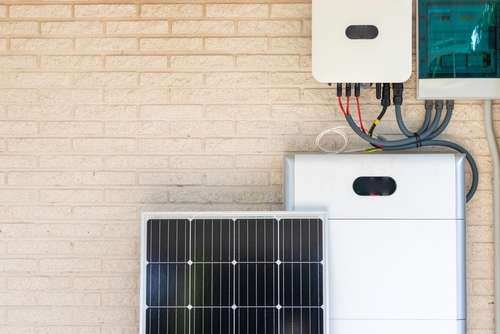Exploring Solar Battery Storage Solutions
In recent years, solar energy has emerged as a promising alternative to traditional power sources, offering both environmental sustainability and economic benefits. However, one of the key challenges with solar power has been its intermittency – the sun doesn’t shine 24/7. This is where solar battery storage comes into play, offering a solution to store excess energy generated during sunny days for use during periods of low sunlight or high energy demand. Let’s delve into the intricacies of solar battery storage systems and address some common questions surrounding them.

What Is Battery Storage for Solar?
Battery storage for solar refers to the practice of storing excess energy generated by solar panels for later use, rather than feeding it back into the grid. By storing surplus energy, homeowners and businesses can increase their energy self-sufficiency and reduce reliance on the grid, thereby saving money and minimising their carbon footprint.
How Does Solar Battery Storage Work?
Solar battery storage systems work by capturing and storing excess electricity generated by solar panels during times of peak sunlight. These systems typically consist of lithium-ion batteries, inverters, and monitoring systems. When the sun is shining and solar panels are producing more electricity than is being consumed, the surplus energy is directed to the batteries for storage. Later, when solar panels aren’t producing electricity, such as during nighttime or cloudy days, the stored energy is drawn from the batteries to power homes or businesses.
What Size Solar Battery Do I Need UK?
To determine the right size of a solar battery for your needs in the UK, you’ll need to consider a few key factors:
Your Energy Usage: The most crucial factor is how much electricity you consume daily. You can find this information on your electricity bills, which will show your usage in kilowatt-hours (kWh).
Solar Panel Output: The size of your solar panel system and its efficiency in generating electricity will play a significant role. The UK has varying amounts of sunlight depending on the season and location, which affects how much electricity your solar panels can produce.
Battery Capacity and Depth of Discharge (DoD): Solar batteries have a stated capacity, often in kWh. However, not all of this capacity is usable due to the battery’s Depth of Discharge (DoD). The DoD is the percentage of the battery that can be used without damaging it. For instance, if a battery has a capacity of 10 kWh and a DoD of 90%, you can use 9 kWh of its capacity.
Days of Autonomy: This refers to how many days you want your solar battery to supply electricity without needing to recharge. In the UK, considering the variable weather, some people plan for 2-3 days to account for days with less sunlight.
Efficiency Losses: No system is 100% efficient. There will be some energy loss when storing and retrieving energy from the battery, as well as from the inverter converting DC electricity from the panels and battery into AC electricity for home use.
To calculate the size of the solar battery you need, you can use the following simplified formula:
Battery Capacity (kWh) = DoD × System Efficiency Daily Energy Usage (kWh) × Days of Autonomy
Remember, this is a simplified approach and various other factors such as peak power demands and future expansion should also be considered. Consulting with a solar energy expert or a solar installation company can provide a more tailored assessment based on your specific circumstances and needs.
How Much Does a Solar Battery Storage System Cost in the UK?
The cost of a solar battery storage system in the UK can vary depending on factors such as the size and brand of the batteries, installation costs, and any additional equipment needed. As of recent data, the cost of a solar battery storage system in the UK typically ranges from several thousand to tens of thousands of pounds. While the initial investment may seem significant, it’s essential to consider the long-term savings on electricity bills and potential government incentives or subsidies available for renewable energy installations.
How Much Battery Storage Do I Need for Solar?
The amount of battery storage needed for solar depends on factors such as energy consumption, desired level of energy independence, and individual preferences. A common approach to sizing battery storage for solar is to consider the average daily energy consumption and aim to install a storage system capable of meeting those needs during periods of low solar generation, such as evenings or cloudy days.
How to Size Battery Storage for Solar?
Sizing battery storage for solar involves assessing your energy usage patterns and determining the amount of backup power required to meet your needs during periods of low solar generation. Factors such as peak energy demand, the size of your solar panel system, and the desired level of energy independence all play a role in sizing the battery storage system appropriately. Working with a reputable solar installer who can conduct a thorough energy assessment will help ensure that your battery storage system is sized correctly to meet your specific requirements.
In conclusion, solar battery storage offers a practical solution to enhance the reliability and efficiency of solar energy systems. By storing excess energy for later use, homeowners and businesses can maximise their energy independence, reduce electricity bills, and contribute to a more sustainable future. As technology continues to advance and costs decline, solar battery storage is poised to play an increasingly significant role in the transition to a clean energy economy.
Battery storage systems can function independently of solar panels, serving various purposes in the energy sector. These systems store electricity from the grid or other power sources during periods of low demand or when electricity is cheaper, and then discharge it when demand is high or when electricity prices are elevated. Here’s how battery storage works without solar panels:
Charging Phase
From the Grid
Battery storage systems can be charged directly from the grid. During off-peak hours when electricity demand is low, or when renewable sources like wind or hydroelectric power are generating excess electricity, batteries can be charged by drawing power from the grid.
From Renewable Sources
In regions with abundant renewable energy resources, battery storage systems can also be charged using electricity generated from sources like wind turbines or hydroelectric plants. Excess energy produced during periods of high renewable energy generation can be stored in batteries for later use.
Storage Phase
Energy Conversion
Once charged, the electricity is converted into chemical energy and stored within the battery cells. In lithium-ion batteries, for example, this process involves moving lithium ions between the positive and negative electrodes of the battery.
Discharging Phase
Meeting Demand
When electricity demand increases or during peak hours when electricity prices are higher, the stored energy is discharged from the batteries and converted back into electrical energy. This electricity can be used to power homes, businesses, or other facilities.
Key Considerations
Energy Management
Battery storage systems often incorporate sophisticated energy management systems to optimise charging and discharging cycles. These systems analyse electricity prices, demand patterns, and other factors to determine the most cost-effective times to charge and discharge the batteries.
Grid Support
Battery storage systems can also provide grid support services such as frequency regulation, voltage control, and grid stabilisation. By rapidly responding to fluctuations in supply and demand, batteries can help improve the reliability and efficiency of the electrical grid.
Backup Power
In addition to providing grid support and optimising energy usage, battery storage systems can serve as backup power sources during outages or emergencies. Stored energy can be used to keep essential services running until normal grid operation is restored.
Overall, battery storage systems play a crucial role in modernising the electrical grid, enhancing energy reliability, and integrating renewable energy sources into the power system. Whether paired with solar panels or operating independently, these systems offer a versatile and sustainable solution to meet the evolving needs of the energy industry.
FAQ
What is the purpose of battery storage systems?
Battery storage systems are crucial for enhancing energy independence and maximizing solar savings. They are particularly beneficial in areas where solar-plus-storage systems provide higher long-term savings compared to solar-only systems.
How do battery storage systems integrate with different electric generation technologies?
Large-scale battery storage, like utility-scale batteries, can be connected along the electricity grid, from power generation points like solar or wind farms, along the transmission network, or at distribution points. This flexibility allows for more renewable energy integration, peak energy demand reduction, infrastructure investment reduction, and grid stability enhancement.
What are the financial benefits of combining battery storage with home solar systems?
Combining battery storage with home solar systems can lead to increased financial savings in several ways. First, it allows homeowners to use more of the solar energy they produce, rather than sending excess energy back to the grid, particularly beneficial in regions where compensation for excess solar energy is low. Secondly, it provides an opportunity to avoid higher electricity rates during peak demand times by using stored solar energy. Additionally, various incentives and rebates for solar-plus-storage systems can further lower the upfront costs and improve the return on investment for homeowners.
When and how is the electricity stored in BESS (Battery Energy Storage Systems) used?
BESS store energy to be used later, offering financial savings and backup power during grid outages. Although batteries can't indefinitely store electricity without losing charge, they provide flexibility in meeting demand with supply.
How efficient are storage systems?
Battery storage systems, especially lithium-ion batteries, offer high efficiency by storing energy and releasing it as needed. They effectively match electricity production with demand, even with the intermittent nature of renewable sources.
Do storage systems cause pollution?
Battery storage systems themselves do not emit localized pollution harmful to human health. They can, in fact, reduce air pollution by displacing fossil fuel–fired power plants, thereby improving public health outcomes in communities where those plants are located.
Reviews
What does the SUNUTI community say?







